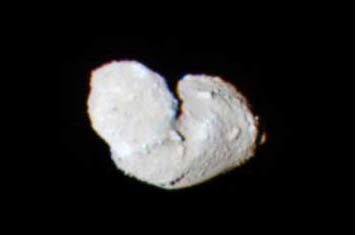Japanese Craft Takes Close-up Photos of Asteroid

The images show sunlight illuminating the asteroid from behind the camera, making the terrain features of the object appear more subdued, said ISAS scientists. The rotation period of the irregularly-shaped Itokawa is about 12 hours.
Hayabusa is almost still in relation to Itokawa, ISAS scientists explain. The spacecraft's residual relative speed toward the asteroid means that Hayabusa "stays within the sphere of influence of Itokawa," they noted.
Calculating the mass of Itokawa is one of the most important science observations in this Hayabusa mission.
The Hayabusa project is a collaborative mission with participation by NASA.
- Hayabusa Reaches Asteroid
- Stardust: NASA's Comet Sample Return Mission
- NEAR Mission: Landing on an Asteroid
Get the Space.com Newsletter
Breaking space news, the latest updates on rocket launches, skywatching events and more!
Join our Space Forums to keep talking space on the latest missions, night sky and more! And if you have a news tip, correction or comment, let us know at: community@space.com.

Leonard David is an award-winning space journalist who has been reporting on space activities for more than 50 years. Currently writing as Space.com's Space Insider Columnist among his other projects, Leonard has authored numerous books on space exploration, Mars missions and more, with his latest being "Moon Rush: The New Space Race" published in 2019 by National Geographic. He also wrote "Mars: Our Future on the Red Planet" released in 2016 by National Geographic. Leonard has served as a correspondent for SpaceNews, Scientific American and Aerospace America for the AIAA. He has received many awards, including the first Ordway Award for Sustained Excellence in Spaceflight History in 2015 at the AAS Wernher von Braun Memorial Symposium. You can find out Leonard's latest project at his website and on Twitter.









